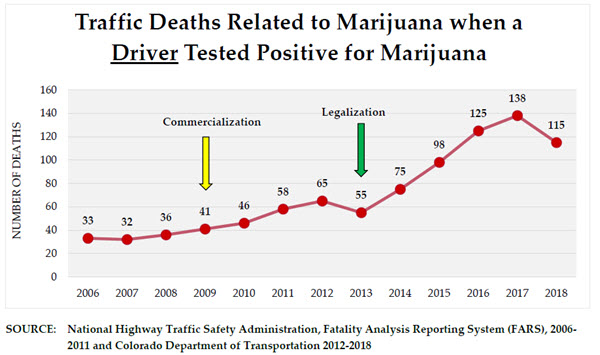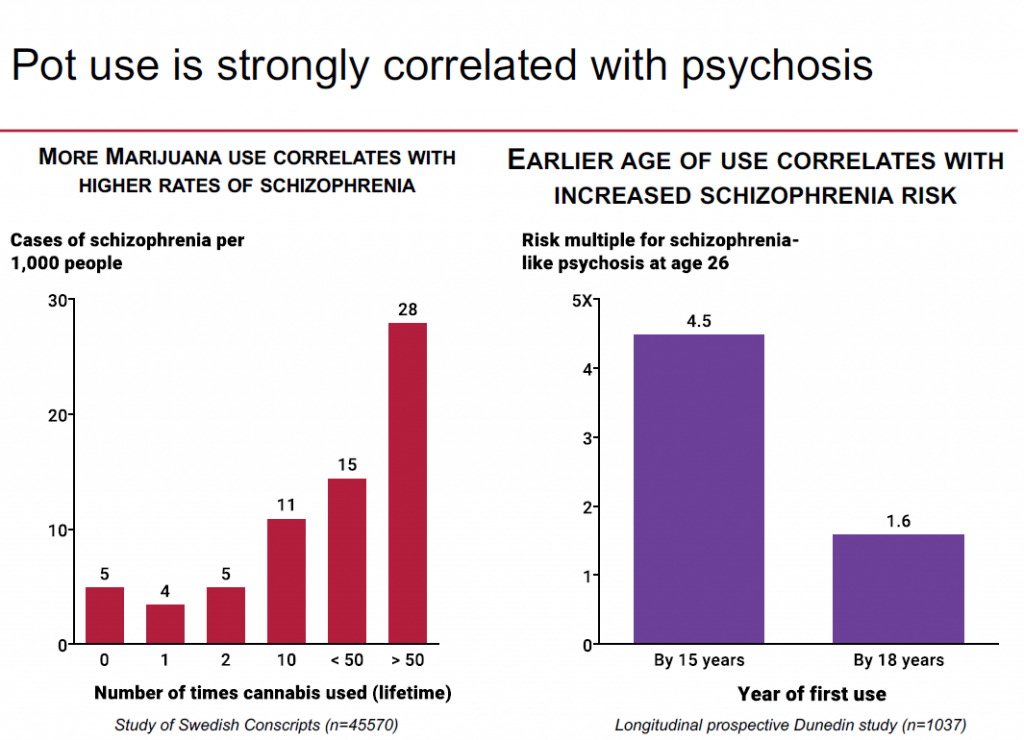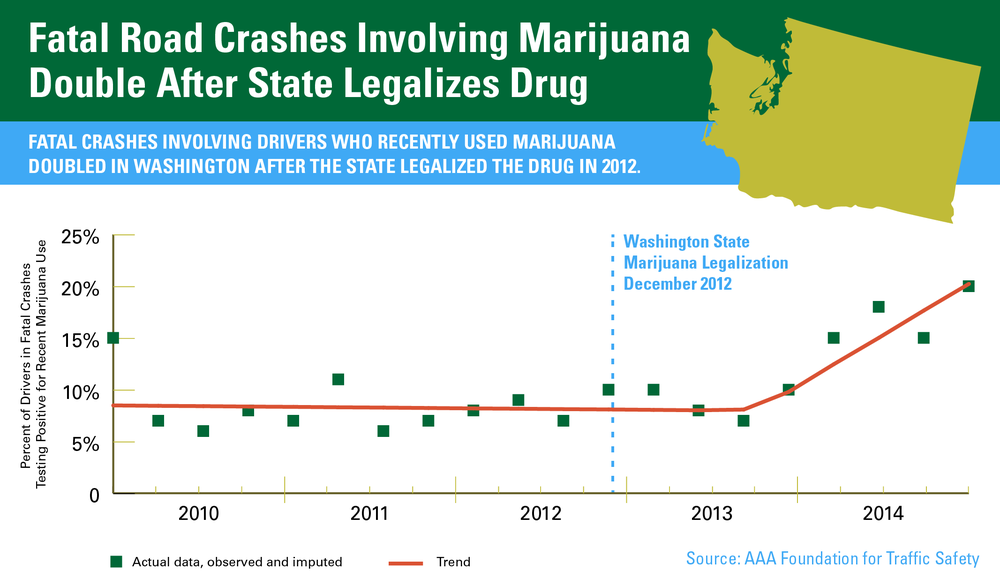 Almost half of the marijuana business in legalised jurisdictions is now in highly potent cannabis concentrates – edibles, dabbing (smoking highly concentrated THC) and vaping. The average psychoactive component of cannabis (THC) of all tested flower last year in Colorado was 19.6%, and the average potency of concentrated extract products was 68.6%. Potency rates of up to 95% have been recorded.
Almost half of the marijuana business in legalised jurisdictions is now in highly potent cannabis concentrates – edibles, dabbing (smoking highly concentrated THC) and vaping. The average psychoactive component of cannabis (THC) of all tested flower last year in Colorado was 19.6%, and the average potency of concentrated extract products was 68.6%. Potency rates of up to 95% have been recorded.
The 2% THC ‘woodstock weed’ has been replaced by popping a handful of gummy bears containing 10 times the legal limit of THC per serving, or a 90% THC dab.
This is definitely not your parent’s pot.
But with increased potency comes increased health risks, including mental illness, psychotic symptoms, suicidal thoughts among teens, respiratory problems, and a greater likelihood of addiction. And addiction is exactly what Big Marijuana wants.
Another claim made by drug advocates is “Nobody has ever died from marijuana.”
This is partly true. Nobody has ever died (that we’re aware of yet!) from an overdose – but what about the effects of getting stoned. Remember – nobody has ever overdosed from tobacco and died, but we don’t say that tobacco is not harmful to our health or hasn’t killed anyone.
The real concern is the effect on mental health and suicide ideation. Marijuana has a variety of other interactions with mental health. Suicidal thoughts can come on very quickly while under the influence in individuals who were not previously suicidal. The suddenness of suicidal ideation means that intervention may not always be possible.
A study published in the American Journal of Psychiatry (July 2019) further links the use of marijuana with the onset of severe mental illness such as psychosis and schizophrenia. The study followed over 7,600 individuals for a mean of 84 months. Among these, the cumulative risk for progression to schizophrenia was 11.3%. The risk for onset of mental illness was highest among marijuana users and lowest for alcohol abusers.
In a longitudinal cohort study of young adults (n = 591) from Switzerland over 30-years, reported in 2020, cannabis use during adolescence was associated with depression and suicidality in adult life. Young age at first use and high frequency of use in adolescence may particularly increase the risk of depression in adulthood. (J Affect Disord. 2020;272:98‐103. doi:10.1016/j.jad.2020.03.126)
“Marijuana killed my soul and ruined my brain”
Sally’s son, Andy, committed suicide after becoming addicted to marijuana. In his suicide note, he said “marijuana killed my soul and ruined my brain.”
The Truth about Marijuana
Colorado toxicology reports show the percentage of adolescent suicide victims testing positive for marijuana has increased.
The percent of suicide incidents in which toxicology results were positive for marijuana has increased from 14% in 2013 to 23% in 2017 (Rocky Mountain High Intensity Drug Trafficking Area 2019)
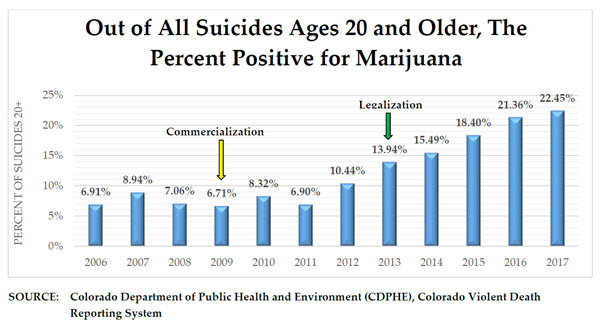 2019 Colorado toxicology reports show the percentage of adolescent suicide victims testing positive for marijuana continues to increase. Between 2011 and 2013, 20.7% of suicide victims between the ages of 10 and 19 tested positive for marijuana (compared with 12.7% who tested positive for alcohol). By 2014-2016, 22.4% tested positive for marijuana (compared with 9.3% for alcohol) (Colorado Department of Public Health and Environment, 2019).
2019 Colorado toxicology reports show the percentage of adolescent suicide victims testing positive for marijuana continues to increase. Between 2011 and 2013, 20.7% of suicide victims between the ages of 10 and 19 tested positive for marijuana (compared with 12.7% who tested positive for alcohol). By 2014-2016, 22.4% tested positive for marijuana (compared with 9.3% for alcohol) (Colorado Department of Public Health and Environment, 2019).
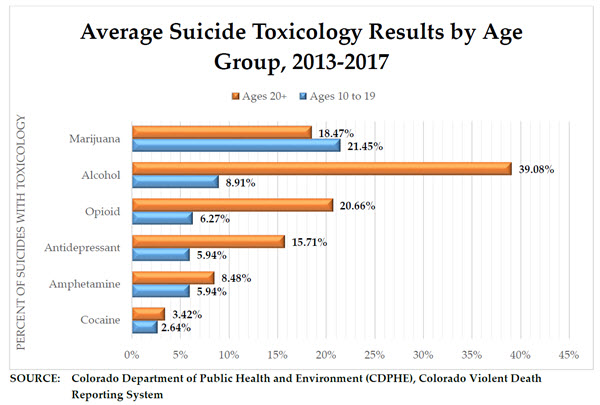 This disturbing trend is, unfortunately, not surprising, as daily marijuana use among youth who begin before the age of 17 significantly increases the risk of suicide attempts. Researchers led by the National Drug and Alcohol Research Centre at the University of New South Wales (and including New Zealand researchers) analysed results of three large, long-running studies from Australia and New Zealand involving nearly 3,800 people. Teenagers who start smoking cannabis daily before the age of 17 are seven times more likely to commit suicide, a study has found.
This disturbing trend is, unfortunately, not surprising, as daily marijuana use among youth who begin before the age of 17 significantly increases the risk of suicide attempts. Researchers led by the National Drug and Alcohol Research Centre at the University of New South Wales (and including New Zealand researchers) analysed results of three large, long-running studies from Australia and New Zealand involving nearly 3,800 people. Teenagers who start smoking cannabis daily before the age of 17 are seven times more likely to commit suicide, a study has found.
Massey University drug researcher Dr Chris Wilkins warned,
“If you’re using high potency, using daily or if you’ve a history of mental illness or drug addiction it can have serious health problems bringing on mental illness or further addiction.”
And University of Queensland Centre for Youth Substance Abuse professor Wayne Hall said legalising the drug would likely have the most significant impact on current users. If cannabis was made more affordable and easier to access, then consumption would increase, like any commodity.
More than 40 clinicians, researchers, scientists, and other public health professionals from Massachusetts, including many from Harvard Medical School, released a Statement of Concern, highlighting negative effects of THC, including “Increased risk of serious mental health problems including acute psychosis (e.g., hallucinations, delusions), paranoia, schizophrenia, depression, anxiety, and suicide, with growing scientific evidence that daily use of high THC products bring greater risk”. They highlight 2018 research from the Copenhagen University Hospital which found that “41% of those who experience cannabis-induced psychosis later convert to schizophrenia.”
In 2019, the liberal state of Vermont, the Department of Mental Health has warned legislators about the mental health implications of a commercial market, stating, “Perhaps the strongest evidence for severe mental health problems related to cannabis use is related to psychosis were multiple studies have linked regular cannabis use to an estimated doubling of the risk of a psychotic illness as well a more refractory course among people with existing psychotic illness. Violent behavior as a result of cannabis induced paranoia and other psychotic symptoms is also an increasing concern.”
In Maryland, neuroscientist and author of “The Impact of Marijuana on Mental Health in: Contemporary Health Issues on Marijuana” Christine Miller warned legislators last month, “The causal link between marijuana use and the development of psychosis is quite simply the most well-replicated, high-impact finding in schizophrenia research today. Given current use rates and the strong potency of the drug available, it stands to be responsible for a larger proportion of schizophrenia cases than any other established factor. Who may be at risk cannot be reliably predicted.”
Legalising cannabis would result in soaring numbers of people suffering from schizophrenia-like psychosis, one of Britain’s top psychiatrists has warned (April 2020). Previously Professor Murray – a professor at the Institute of Psychiatry at King’s College London – had supported tightly controlled legalisation married with public education campaigns spelling out the risks, but growing evidence about the harm cannabis causes had made him change his mind about legalising the Class B drug. He said the experience of places that had decriminalised or legalised it – from Portugal and the Netherlands to swathes of North America – had made him think again.”
NEW STUDIES: Nov 2019 – More than a third of people who experienced psychosis with cannabis use later transitioned to schizophrenia, according to a systematic review and meta-analysis published online in Schizophrenia Bulletin. Similarly, schizophrenia transition risk among people who experienced psychosis from hallucinogen or amphetamine use was also considerable. “These findings have important implications for mental health care and services. Substance-induced psychoses are common reasons for seeking mental health care.” The meta-analysis spanned 50 studies which provided 79 estimates of transition to schizophrenia among 40,783 people with substance-induced, brief, or atypical psychoses. Some 25 of the studies, which included 34,244 people, had substance-specific estimates. Overall, 25% of people who experienced substance-induced psychosis transitioned to schizophrenia, researchers reported. The rate of transition for people who transitioned to schizophrenia after brief, atypical, or not-otherwise-specified psychoses was 36%. The highest rates of transition to schizophrenia were associated with cannabis-induced psychosis (34%).
A 2019 study in the Lancet involving, among others, researchers at King’s College London, compared 900 people who had been treated for psychosis with 1,200 people who had not. Sample participants were drawn from across Europe and Brazil. Both groups were surveyed on a host of factors, including their use of marijuana and other drugs. The study’s authors concluded that “people who smoked marijuana on a daily basis were three times more likely to be diagnosed with psychosis compared with people who never used the drug. For those who used high-potency marijuana daily, the risk jumped to nearly five times.” By “high-potency” the researchers meant marijuana with a THC content of more than ten percent. Today, it’s not uncommon to read of marijuana that’s legally-sold in places like Colorado with THC content above 20 percent and, occasionally even 30 percent.
CANNABIS WITHDRAWAL
A review and meta-analysis with over 23,000 participants conducted by researchers from Queen’s University in Ontario and the University of Calgary and published in the JAMA Network Open in March 2020, found that 47% of regular marijuana users experience symptoms of Cannabis Withdrawal Syndrome (CWS) when they cease use of the drug. The study’s authors said that because “many CWS criteria are depression or anxiety symptoms, regular users may seek cannabis to obtain short-term symptom relief, unaware that this use could perpetuate a longer-term withdrawal problem.” Also, a review of recent research published in the journal JAMA Psychiatry, states that in the states that have legalised marijuana, prices for the drug have decreased, while use and dependence has increased among adults. Furthermore, the review states that the risk of dependence has risen from around 9% in the early 1990s, to nearly 30% today.
DEATHS ASSOCIATED WITH MARIJUANA CONSUMPTION
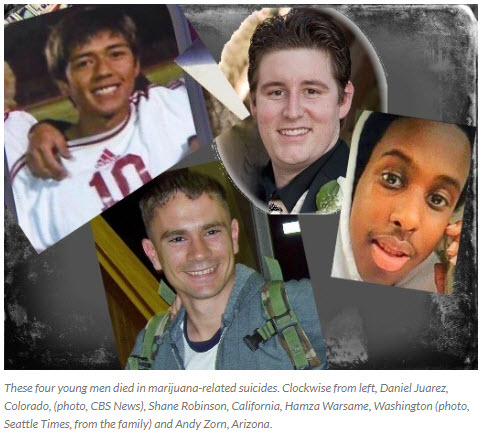 Exchange student Levy Thamba (19) falls to death in Denver after eating marijuana cookie – April 2014
Exchange student Levy Thamba (19) falls to death in Denver after eating marijuana cookie – April 2014
Luke Goodman (23) fatally shoots himself after eating 5 marijuana candies – Mar 2015
Daniel Juarez (18) Stabbing Suicide Latest Death Linked to Marijuana Intoxication – May 2015
Marc Bullard, 23, Colorado
Brant Clark, 17, Colorado
Shane Robinson, 25, California
Rashaan Salaam, 41, Colorado
Hamza Warsame, 16, Washington
Andy Zorn, 31, Arizona
Tron Dohse, 26, Colorado. Dohse’s death was determined to have been an accident. Unable to find his keys, Dohse climbed up the apartment building and fell. The toxicology report 27.3 ng. of marijuana in his blood, but no other drugs or alcohol in his system. As his sister told CBS, she believes marijuana impairment led her brother to make poor decisions the night of his death.
John Kehl, 67, Canada. The court heard cannabis-induced psychosis, not a major mental disorder, spurred the brutal death (stabbing and beheading) of Kehl by his then 31-year-old son Adam.
“Neither my husband nor I ever touched illegal drugs, or used pharmaceuticals. Parents who think they raised their kids sensibly, spent quality time with them and modeled a healthy lifestyle need to be forewarned. Our kids are surrounded by a culture of pot. No family is safe.”
Lori Robinson – Shane’s mum
READ MORE: www.CanPotKill.me
 Here in New Zealand, a toxicology test revealed the pilot of the balloon that crashed in Carterton in 2012 had cannabis in his system. Pilot Lance Hopping, 53, and 10 passengers died when the hot air balloon collided with power lines and caught fire near Carterton. Although there was no proof the pilot had used cannabis before the flight, statements from people who knew him, as well as post-mortem forensic tests, revealed that he was a weekly cannabis user and the long term effects of using the drug could have had an “effect on his perception and thinking”.
Here in New Zealand, a toxicology test revealed the pilot of the balloon that crashed in Carterton in 2012 had cannabis in his system. Pilot Lance Hopping, 53, and 10 passengers died when the hot air balloon collided with power lines and caught fire near Carterton. Although there was no proof the pilot had used cannabis before the flight, statements from people who knew him, as well as post-mortem forensic tests, revealed that he was a weekly cannabis user and the long term effects of using the drug could have had an “effect on his perception and thinking”.
DUI
And don’t forget the effect on driving. Since recreational marijuana was legalised in Colorado, marijuana related traffic deaths increased 151%, more than doubling from 55 in 2013 to 138 people killed in 2017. According to AAA, Washington State experienced a doubling in drugged-driving fatalities in the years following legalisation.
One Mother’s Story
Corinne Gasper’s 22-year-old daughter, Jennifer Hrobuchaka, was killed by a drugged driver in July 2012. “She was driving into work when she was hit by a man high on marijuana, racing through an intersection at 82 miles per hour into her passenger side,” Gasper said.
Since recreational marijuana was legalised, traffic deaths in which drivers tested positive for marijuana increased 109% while all Colorado traffic deaths increased 31% (Rocky Mountain High Intensity Drug Trafficking Area 2019)
